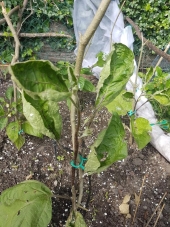posted 8 years ago
What Crops are Affected?
Even very small amounts of picloram, clopralid and aminopyralid - as little as 1 ppb - can negatively affect sensitive plants. Dow, the manufacturer of these herbicides, claims that only a few plants are affected. The average home gardener may beg to differ. Sensitive plants include:
Legume family - including lupines, peas, beans and clover.
Compositae family - including daisy, aster, sunflower and lettuces.
Nightshade family - including tomatoes, potatoes, peppers and eggplants.
Umbelliferae family - including carrots.
Many other vegetables and flowers.
Sensitive plants are exposed to these herbicides develop cupped or fern like leaves and twisted stems. They do not produce well, though in theory the crop is safe for you to eat.
Residues of Picloram, Clopyralid or Aminopyralid Herbicide Create Killer Compost
Minute concentrations of picloram, clopyralid and aminopyralid, as low as 1 ppb (parts per billion), can be lethal to sensitive garden plants such as peas, beans, lettuce, spinach, tomatoes and potatoes.
Most pesticides, including herbicides, break down quickly in the composting process. Picloram, Clopyralid and Aminopyralid do not. These chemicals are
Easily absorbed by plants.
Remain chemically stable and intact in both live and dead plants.
Do not breakdown substantially in animal digestive tracts so contaminate manure, urine and bedding with residues.
Breakdown very slowly in composts and soils with an estimated half life of 1 - 2 years.
Affect sensitive crops at very low concentrations - 1-3 ppb.
The only way to handle this potential threat is to keep materials contaminated with picloram, clopyralid and aminopyralid out of your garden in the first place.
Trade Names Please
When you're talking to a farmer supplying hay, straw or manure asking about picloram, clopyralid and aminopyralid is probably not enough. You'll need to ask about specific trade names of the herbicides.
These herbicides are sold under the following trade names.
Picloram - sold as Tordon, Access, Surmount, Grazon, and Pathway.
Clopyralid - sold as Curtail, Confront, Clopyr AG, Lontrel, Stinger, Millennium Ultra, Millenium Ultra Plus, Reclaim, Redeem, Transline.
Aminopyralid - sold as Milestone, Forefront, Pharaoh, Banish.

 1
1




 2
2






















 1
1








 2
2













 1
1












![Filename: amino_pictogram.gif
Description: [Thumbnail for amino_pictogram.gif]](/t/64310/a/49004/amino_pictogram.gif)
 1
1








